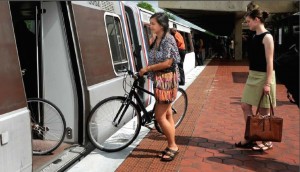
While Millennials expect to buy a car at some point, they are more likely to use public transit options when it is more cost effective.
With younger generations struggling with car ownership and a push by some cities to limit access by vehicles, it would make sense that public transportation usage is going to rise…and it did in 2013 by 1.1%.
There were 10.7 billion trips taken last year on buses, trains and other forms of public transportation, marking eight consecutive years of more than 10 billion trips, according to the American Public Transportation Association (APTA). It was also the highest number of trips since in 57 years.
The use of public transport has been in the rise for some time now. Since 1995 public transit ridership is up 37.2%, outpacing population growth, which is up 20.3%, and vehicle miles traveled (VMT), which is up 22.7%.
The year-over-year increase can be attributed to a few things, including the aforementioned factors as well as an improving economy.
“When more people are employed, public transportation ridership increases since nearly 60% of the trips taken on public transportation are for work commutes,” said Michael Melaniphy, APTA president and CEO.
The increases are not limited to one region of the country or population size. Some of the cities reporting record ridership include: Ann Arbor, Mich.; Denver; Espanola, NM; Fort Myers, Fla.; Indianapolis; Los Angeles; New Orleans, LA; Riverside, Calif.; Salt Lake City, Utah; and New York City.
Below is a breakdown of the ridership in 2013:
- Heavy rail (subways and elevated trains) ridership increased by 2.8%
- Commuter rail ridership increased by 2.1%
- Light rail (modern streetcars, trolleys, and heritage trolleys) ridership increased 1.6%
- Bus ridership increased by 3.8% in cities with a population of below 100,000
Bus ridership overall was down 0.1%. However, as some large cities, such as New York, cut off access to certain areas, those numbers are expected to rise. The city sealed off much of Times Square from cars and trucks to make it easier for tourists to move around in the area. Other cities are contemplating similar measures as a way to improve either pedestrian traffic or they are looking at restricting vehicle access to improve traffic flow through the cities.
Also other places, such as Detroit, are putting a renewed emphasis on improving public transportation, such as buses, to help residents get to jobs.
(New Jersey pulls the plug on Tesla. For more, Click Here.)
“We’ve got to make the bus system first class in this city. I’m going to work really hard to do it,” Detroit Mayor Mike Duggan told the Detroit Free Press in January.
Finally, the stories of Generation Y being more interested cell phones than cars may have been overstated; however, they are buying cars in smaller numbers due to the costs of a car.
(Click Here for more about how average Americans are being priced out of autos.)
A study by CNW Marketing indicates that almost 10% of American households have no vehicles at all, with an emphasis on those homes headed by younger consumers.
But a Deloitte LLP study indicates that many are looking to get into the automotive market. In fact, three in five Gen-Y consumers expect to purchase or leave a vehicle within the next three years.
(To see more about the Justice Department’s investigation of the GM recall, Click Here.)
If they can afford one, that is, the Deloitte study indicating that for 80% of Millennials cost is the biggest barrier to ownership. The average new vehicle sold in the U.S. hit $32,900 in December, an $882 increase year-over-year, and up a full $4,410 from December 2010, according to CNW Marketing.
Until then, they are part of the increasing numbers of public transportation users. According to a separate APTA study, Millennials are more likely to use multiple forms of transportation to get to their daily destinations. Typically they chose the easiest, least expensive way to get around, even when they own a car and expect to do so for the foreseeable future, indicating public transportation use will continue to increase among that age group. Additionally, there is a trend of Baby Boomers moving back into urban areas and they too are using public transit at higher levels, according to APTA officials.
